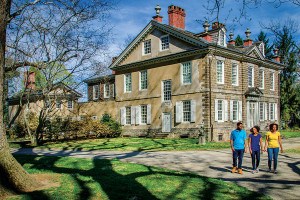After the Hangover: How Old City Finally Sobered up and Crafted a Grown-up Vision for Itself
We called it the “Land of 1,000 Snookis,” and judging by the wounded comments we got, that hurt.
In the 2010 story “What the Hell Happened to Old City?,” Philly Mag’s Richard Rys reported that the neighborhood’s late-1990s promise — fueled by an enticing mix of high-end restaurants, cool boutiques and celeb-friendly lounges, much of it housed in repurposed historic buildings and all anchored by Stephen Starr’s pioneering spots Continental and Buddakan — had curdled under a relentless every-weekend assault by drunken young clubbers. Residents who’d snapped up million-dollar condos after lapping up the hip daytime and weeknight vibe were checking out as soon as they were lucky enough to find buyers. Local business leaders felt that City Hall, content to keep the raucous behavior roped off from other areas of the city, wasn’t interested in addressing the mess.
Though neighborhood organizations had sporadic success dealing with the so-called nuisance bars and clubs in the zone bordered by Market and Chestnut streets from Front to 3rd — Cebu, a former VIP magnet that had fallen far, was a notable early closure — it’s only relatively recently that a concerted mix of planning and enforcement has truly clicked. The result: Notorious clubs such as Grey Social Lounge, Mint, 32˚ and Blurr, along with about 10 similar establishments and their fly-by-night party promoters, are finally gone, and a new scene is emerging.
Neighborhood players point to August 2014 as a turning point. That’s when Job Itzkowitz, the former deputy chief of staff for Councilwoman Cindy Bass, was named executive director of the Old City District. Among other initiatives, Itzkowitz has used his first year on the job to promote continual engagement among OCD, its residents and visitors, and its businesses.
An OCD-backed security detail now patrols the area on weekends, and a walkie-talkie system between bars has helped security zero in on patrons who may have been tossed from neighboring watering holes. “[Bars and clubs] are almost self-policed now,” says Harvey Spear, head of OCD’s Clean & Safe Committee. “They know they’re not going to get away with it. Other restaurants now say, ‘We know [nuisance behavior] is going on, and we don’t like it.’”
Another group, the Old City Nuisance Task Force, has continued to make major strides in negotiating conditional licensing agreements with incoming business owners seeking liquor licenses, a practice that encourages higher and better uses of drink-serving locations in the neighborhood and seeks to create conditions in which nuisance behavior won’t occur. Police captain Brian Korn, a task force member and commanding officer of the 6th District, whose footprint includes Old City, agrees that there’s been a change on 2nd Street: His weekend patrols are reporting a decrease in rowdy activity, violence and overall incidents in the past year.
New, higher-end restaurants are perhaps the most obvious sign of the changes. In 2013, Han Dynasty took over the massive former club space at the corner of 2nd and Chestnut. The owners of the Khyber Pass Pub, Stephen Simons and David Frank, are currently overhauling the neighboring space formerly occupied by the dance club Glam for a new restaurant concept called Bistro 52.
The calming of the street scene has seemingly reignited residential interest, too. Old City has roughly 1,000 new units on deck over the next few years, including 59 apartments recently completed at 3rd and Market. Part of that site used to house Lucy’s Hat Shop, another pub where plastered patrons were once plentiful.
The next big step for Old City is a 10-year master plan dubbed “Vision 2026,” expected to be released by the end of the year. An OCD survey informing the plan drew nearly 500 respondents, most of whom focused on the neighborhood’s future —optimizing green space, dealing with population density, improving transit access, attracting diverse businesses, and enhancing bicycle and pedestrian experiences — rather than its sordid recent past.
Stephen Starr, who readily admits that lately he’s in bed by the time the bars let out, thinks Old City is still far removed from its heyday but is poised for a comeback: “I think it’s got great potential. It just needs a couple of lucky breaks and a city that cares.”
Published as “After the Hangover” in the December 2015 issue of Philadelphia magazine.


